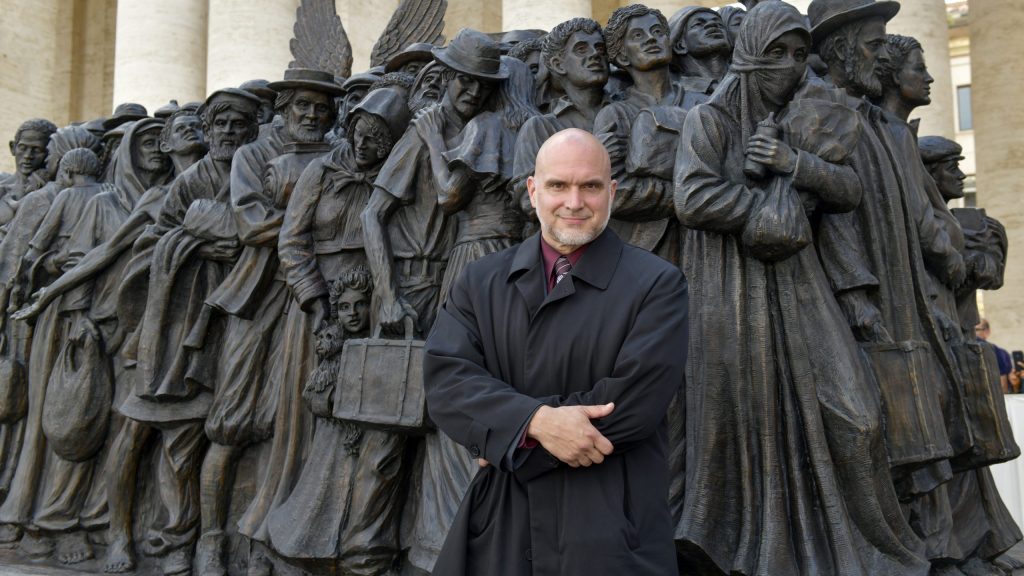Tired and heartbroken at seeing statues get pulled down and vandalized, Canadian sculptor Timothy Schmalz wracked his brain to come up with a compromise that would both preserve the artwork, and acknowledge the flawed nature of many historical figures.
Schmalz has been a sculptor for 30 years and is perhaps best known for his “Homeless Jesus” sculpture and the "Angels Unaware" statue dedicated to migrants in St. Peter’s square. He told CNA that he believes sculpture is a unique and powerful method of preaching.
He said it made him upset “beyond belief” watching the news and seeing statues of figures such as Christopher Columbus and St. Junípero Serra be torn down.
“I know the amount of time that is spent working on each sculpture and a lot of these sculptures were done a century ago and the skill level, the time that it's been put into that--just on a simple work ethic and good craftsmanship and time and love that is put into it,” he said.
“To see that being pulled down and destroyed just really breaks my heart,” Schmalz added.
Sculpture, he said, is different from other art forms, as unlike a play or a piece of music, it is intended to be permanent.
“Its basic presence is that of time enduring,” he said. He told CNA that seeing what he called “a random mob” destroy statue after statue felt like watching “wanton violence against our culture.”
The statues, Schmalz said, are works of art being used as scapegoats for the country’s perceived historical sins.
“They’re visual ambassadors of that history, and to destroy it--[its] absolute arrogance.”
Instead of destruction, Schmalz is advocating for more creation.
“I'm a sculptor, I'm a creative, I create, I do not destroy, and I wish more people would follow the role model of creating rather than destroying,” he said.
Creation, Schmalz explained, is far more difficult than destruction. Some of the statues that were destroyed took years to make, “and they’re toppled in 15 minutes.”
“I want to be in a culture that is one of creating, not one of destroying. And, and what I say is that if you have a problem with that sculpture, let's create more sculptures, let's create more stuff.”
And creating “more stuff” is just what Schmalz is doing.
He sculpted what he has dubbed the “Monument of Oppression”--a sculpture of two arms extending outward behind a barred window--which he says he hopes could be installed as a “supplementary sculpture” beside controversial works of art, offering it as a compromise that could save more works of art from destruction.
The Monument of Oppression would be “a layer of art on top of a layer of art,” and would serve as a reminder that there is a complicated history behind many notable persons which should be marked.
As a sculptor, and as one who concentrates on religious-inspired art, Schmalz rejected the idea that statues of a European-styled Jesus should be taken down, but did say that there should be a wider embrace of images of Christ as various ethnicities, saying he has himself made many African-styled images of Christ and the Holy Family, including an African-American crucifix for the Archdiocese of Atlanta.
“Jesus does not have a color. Jesus doesn't necessarily care,” he said. “Artwork is a bridge for people. And so if I have the opportunity to make a Jesus for a European place, fine. And an African-American Corpus should be in Atlanta, Georgia, because there's so many people of African descent there.”
The depiction of Jesus as various ethnicities “has nothing to do with anything, but making artwork that fits the audience and you have the painters doing the same,” he said, noting that Jesus was often depicted in the clothing of the Middle Ages or Renaissance, and that the actual Last Supper “probably wouldn’t have had a European table and chairs.”
“It doesn't matter,” he said.
“Artwork is a communication, and that has to be spoken in a language that people could understand.”

